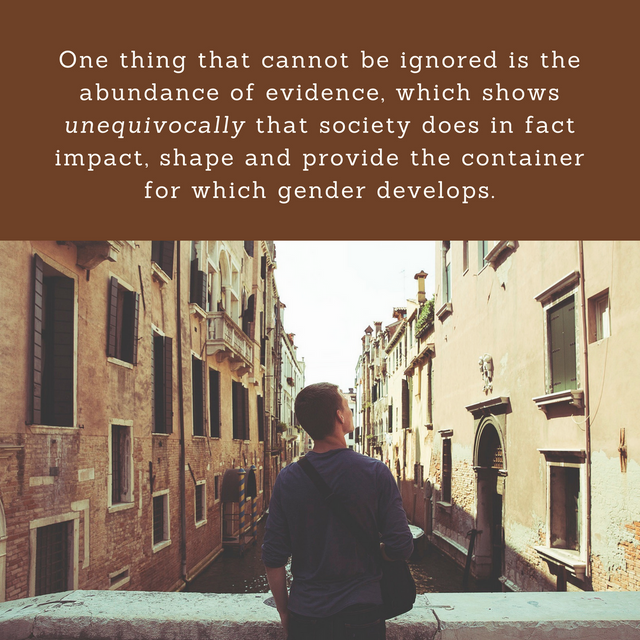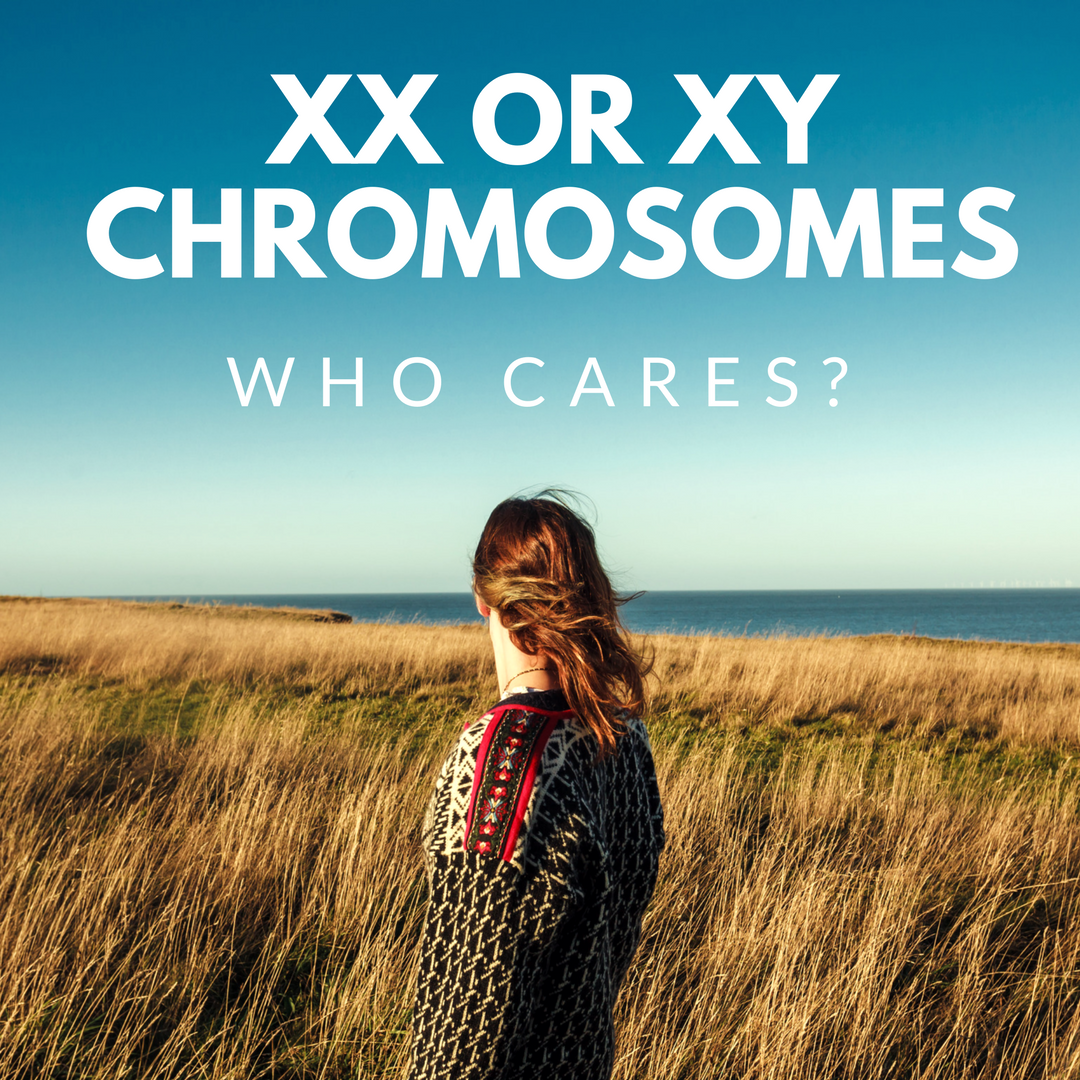Gender is not purely biological

The topic of gender, and the ensuing debate regarding exactly what gender is, comprises many facets from the biological standpoint of physical components of the human body all the way through the complex nature of gender assigned roles. There are many psychological theories that attempt to explain the exact nature of gender and how it is developed, but the two main theories are biological and social learning. The essential question is whether or not the gender people take on is determined simply by the biological makeup of their DNA or if, instead, society instead shapes what it means to be a man or a woman.

Evidence from various disciplines of science posit different evidence which contradicts those who would state biology is the predominant factor in determining gender differences and offers instead a mixed approach to the definition of gender.
Proper scientific study of gender is faulty and constantly evolving
One of the most difficult problems facing those studying gender differences is the true definition of gender in what is a rapidly changing world and environment. Van Leeuwen (2013) specifically talks about these difficulties and points out that many times the psychological differences between men and women can barely be distinguishable and even when they can be suffer from inconsistency. This is not to state that men and women do not have different psychological thought patterns but more so that the ability to detect these thought patterns consistently between them can be troublesome.
Furthermore, Van Leeuwen (2013) points out that science suffers from being unable to properly select independent variables of XX or XY chromosomes and then manipulate them randomly. This argument indicates that scientific basis for gender research is predominantly flawed especially in the context of a proper study, which follows traditional conventions. If these factors limit the ability to properly study gender differences how can psychologists or researchers tout a particular belief structure? The answer is that society plays a role to various degrees and also at various points in the development of life from preschool to old age, gender is always in flux and development.
Gender is introduced and reinforced during preschool years
At the first stages of early childhood development it is easy to see gender stereotypes being introduced from various levels including parents and caregivers who, unwillingly or willingly, push children into specific identifying behaviors. According to Shaffer (2009) even the basic acts of providing specific toy preferences or color choices such as pink and blue automatically begin the wiring process of gender. In fact, this process could be identified as beginning even before birth with parents choosing nursery colors and motifs designed to speak to the gender of their unborn child. The results of these kinds of activities can be seen through the comparison of gender-schematic and gender-aschematic preschool students where those considered gender-aschematic play with less traditional gender specific toys than gender-schematic preschool students according to a study by Wilansky-Traynor and Lobel (2008). Their study illustrated differences in toy selection behavior and can be directly observed along their gender lines indicating that the way in which a parent chooses to raise their child does have direct results on their choices (Wilansky-Traynor & Lobel, 2008).
Further reinforcing these roles and behaviors for preschoolers is the presence of gender stereotyping found in the books that they read. Traditionally, books for preschoolers have been predominantly picture books that strongly reinforce gender stereotypes according to societal norms (Oskamp, Kaufman & Wolterbeek, 1996). Oskamp et al., (1996) contend that although gender roles have gotten better over time, there is still significant stereotyping, which incurs thus reinforcing the idea that this is a learned behavior.
Gender stereotyping and development influences adolescent behavior
As youth move into adolescence, the prevalence of gender roles continues to be reinforced by a number of different societal influencers. Adolescent youth typically engage in risky behavior that includes experimenting with things such as alcohol and binge eating (Williams & Ricciardelli, 2003). What is interesting about these kinds of behaviors however is that those who are negatively attached to stereotyping of gender, that is they closely associated with their believed notion of gender, experience to a greater degree self-control issues (Williams & Ricciardelli, 2003). Furthermore, these same adolescents find themselves again reinforcing the ideas of stereotyping such as alcohol abuse being associated with masculinity and binge eating as feminine whereas students who are positively associated with gender stereotypes do not (Williams & Ricciardelli, 2003).
This leaves then the understanding , along with other studies, that adolescent development can play a great role in gender development (Steensma, Kreukels, deVries & Cohen-Kettenis, 2013). In fact, Steensma et al. (2013) provide examples of disorders of sexual development that occur specifically during adolescence which furthers the concept of gender developing during years of lifespan development.
Gender is predetermined but not guaranteed
While traditional biological understanding of gender is tied directly into the development of sexual organs and XY chromosome development, significant evidence exists to posit that it is not a one size fits all approach (Steensma et al., 2013). Earlier work from Adams and Marshall (1996) also corroborate this viewpoint and contest that regardless of the sexual organs and brain development, substantial impacts from society can and often do contribute to what someone considers their identity.

There is of course something to be said about the biologically defined concepts of gender and the basic concepts surrounding the physical structure of the human body, including sexual organs and chromosomes, that help categorize people for various purposes. Where these defintions fail, however, is when people do not fit squarely into these defined physical constructs. As Adam and Marshall (1996) discuss in their work, the problems arise when a person feels, and has felt for a long time, that their physical properties are not indicative of their gender. So while a child may be born with physical appearance matching that of a male, it is not a guarantee that their psychological construct will match this and therefore it becomes their own journey of discovery of who they are.
Evolutionary theory places a somewhat connected theory to social learning, possibly even complimentary, that gender is most closely connected to evolutionary forces which have pushed men and women into preordained roles based on the pressures found in the world (Shaffer, 2009). This kind of approach makes most sense when considering the physical constructs of the human body for example with men being more physical in structure able to hunt for food or protect from predators (Shaffer, 2009). Shaffer (2009) is quick to point out that although an evolutionary theory sounds like it might fit with the understanding people have of how gender roles develop, there are many criticisms and periods of time where the theory just does not hold up.
There are a number of periods in life that contribute to the development and growth of the human body. Coupled with those periods are distinct sections of psychological growth related to gender role assignment and society plays an impactful role in the outcome of these sections. Undoubtedly there are certain biological features that contribute to the overall gender identity a person ends up assuming.
The question that remains is how much of the gender debate is predisposed by the physical construct of the person and how much can be directly attributable to environmental factors? One thing that cannot be ignored however is the abundance of evidence, which shows unequivocally that society does in fact impact, shape and provide the container for which gender develops.
References
Adams, & Marshall. (1996). A developmental social psychology of identity: understanding the person-in-context. Journal Of Adolescence, 19(5), 429-442. doi:10.1006/jado.1996.0041
Shaffer, D. (2009). Social and personality development, 6h ed. Australia Belmont, CA: Wadsworth/Cengage Learning.
Oskamp, S., Kaufman, K., & Wolterbeek, L. (1996). Gender Role Portrayals in Preschool Picture Books. Journal Of Social Behavior & Personality, 11(5), 27-39.
Steensma, T., Kreukels, B., de Vries, A., & Cohen-Kettenis, P. (2013). Gender identity development in adolescence. Hormones And Behavior, 64(2), 288-297.
Wilansky-Traynor, P., & Lobel, T. E. (2008). Differential Effects of an Adult Observer’s Presence on Sex-Typed Play Behavior: A Comparison Between Gender-Schematic and Gender-Aschematic Preschool Children. Archives Of Sexual Behavior, 37(4), 548-557. doi:10.1007/s10508-008-9342-0
Williams, R., & Ricciardelli, L. (2003). Negative perceptions about self-control and identification with gender-role stereotypes related to binge eating, problem drinking, and to co-morbidity among adolescents. Journal Of Adolescent Health, 32(1), 66-72.
Van Leeuwen, M. (2013). Social Science Studies Cannot Define Gender Differences. Priscilla Papers, 27(2), 12-19.
Please upvote, resteem and comment on this important topic! We're serious here at Live Rehab about challenging the societal norms of addiction, recovery, mental and sexual health.
This post has received gratitude of 1.00 % from @jout
@originalworks
The @OriginalWorks bot has determined this post by @liverehab to be original material and upvoted(1.5%) it!
To call @OriginalWorks, simply reply to any post with @originalworks or !originalworks in your message!
Congratulations! This post has been upvoted from the communal account, @minnowsupport, by liverehab from the Minnow Support Project. It's a witness project run by aggroed, ausbitbank, teamsteem, theprophet0, someguy123, neoxian, followbtcnews/crimsonclad, and netuoso. The goal is to help Steemit grow by supporting Minnows and creating a social network. Please find us in the Peace, Abundance, and Liberty Network (PALnet) Discord Channel. It's a completely public and open space to all members of the Steemit community who voluntarily choose to be there.
If you would like to delegate to the Minnow Support Project you can do so by clicking on the following links: 50SP, 100SP, 250SP, 500SP, 1000SP, 5000SP. Be sure to leave at least 50SP undelegated on your account.
My response
https://steemit.com/gender/@tealdaubs/tl-dr-gender-john-money-and-how-a-failed-study-became-a-social-norm
It's not really much of a response though is it? Your response is assuming that this one person is the only influence in this area and that all theories lead back to him and his awful experiment. By the same token then if we find any scientific study which suggests gender is sexual only to be conducted by someone of ill-repute then it would refute the whole area of study.
It's also really hard to take your response seriously when you use a hate meme as your channel art :(
I'm saying that the whole basis of your hypothesis was studied from birth only ONCE and it ended with 2 suicides. I'm saying there's no other true study, unless you count that suicide is a popular trend for transexuals. I'm saying the whole idea of gender being a social construct is fundamentally flawed. All you're saying is "Well that's just one study!" without listing out any other studies that prove otherwise and using ad hominem to justify your incorrect statement.
The adhominem is separate and there are plenty of sources listed to support my hypothesis listed in the resources section. Look you don't have to agree but I can tell you my hypothesis has literally 0 to do with that freakshow you wrote about. I appreciate a good argument and constructive discussion. So, if my hypothesis has nothing to do with that guy where do you go from there?
So first, simply saying "it's in this book" isn't good enough proof, list quotes, show statistics. Also to say your hypothesis about gender has nothing to do with the person who created the word and basis for your hypothesis is objectively incorrect.